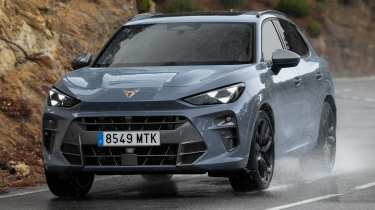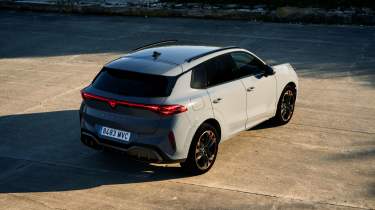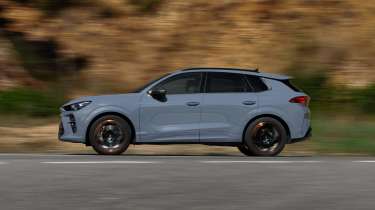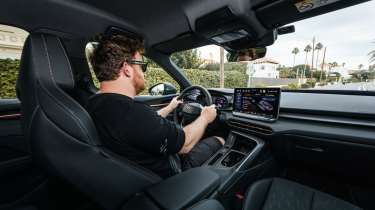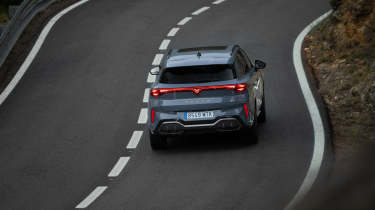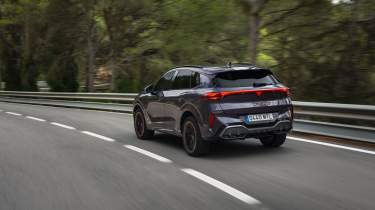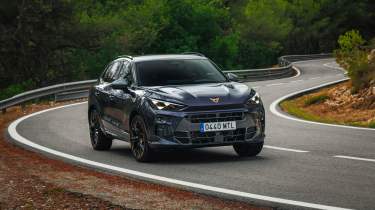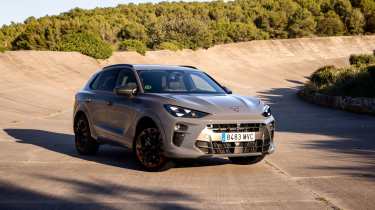Cupra Terramar VZ 2024 review – a soft-focus sporty SUV
Available as a 268bhp PHEV or a 261bhp pure-combustion variant, it’s the latter Terramar VZ you want if you need your family SUV to be fun
Cupra is a new brand that’s stuck between a rock and a hard place. On the one hand, it’s a fresh, sporty, quintessentially Spanish brand grown out of a line of hot Seats that has real style and performance potential. On the other, it’s one among a few in the Volkswagen Group stable tasked with imbuing shared underpinnings with what attitude and style it can.
We’d hoped for a sports car when Cupra became a brand all of its own in 2018 but so far, we’ve seen a raft of EVs and SUVs. Of the former, the Terramar is the latest, riding on the MQB Evo platform, and a move by Cupra to ‘grow up’ but ‘without losing our rebellious and challenger spirit’, according to CEO Wayne Griffiths.
Let’s not dismiss it out of hand, though, because there’s good stuff here. It’s available in VZ form – short for Veloz, Spanish for fast – with the potent turbocharged four-cylinder or plug-in hybrid power plants depending on your tastes. There’s also the option of big brakes, Cupra specific handling tuning and hardware and stability control you can turn off.
In typical Cupra style, it also looks pretty sharp, but do the dynamics back that up to make the Terramar a worthy car all of its own, or does it do the century-old race track and Spanish Balearic Sea overlook to which it owes its name a disservice?
The Cupra Terramar’s aggressive style renders the likes of the Volkswagen Tiguan and Skoda Kodiaq sturdy and staid. It does look good, with the ‘wave’ signature on the D pillar designed to reflect the ‘Mar’ – sea in Spanish – in the Terramar’s name. The new three-light signature at the front now features Matrix LED Ultra tech that can dance and project, beyond simply being on or off. It seems Audi doesn’t get to keep all the really good stuff.
Inside the Terramar is pleasant in appearance, with the driver-centric layout incorporating more of that ‘wave’ motif, while positioning the touchscreen – and the various vital controls hidden within – closer to the touch and closer to your line of sight. That makes the job of navigating it on the move less precarious. Happily, the steering wheel still has all physical controls, too. That screen is the now ubiquitous 12.9-inch item seen in most Cupras, Skodas and VWs. It’s responsive enough and Cupra’s revised UI is intuitive. Apple CarPlay and Android Auto are a given. There’s also a head-up display that’s informative but not too invasive.
All the bronze trim highlights in the VZ First Edition we drove are distinctive, as they are on all Cupras. The ingot-like door handles deserve a special mention. Interior ‘characters’, as Cupra calls them, range from Deep Ocean – dark blue, featuring recycled marine plastics, Moon Light, featuring 73 per cent recycled materials and High Canyon, featuring plant-tanned leather. Beyond the waxy leather seats however, there’s a sense that everything’s not quite to the highest quality – to the touch and to look at. It’s roomy enough in the back, if not quite as airy as some family SUV rivals, especially if you don’t get the panoramic roof. A note of caution too, that the PHEV drops boot capacity from give or take 600 litres, to less than 500 litres.
Okay, what about the oily bits? As above, the Terramar VZ – the highest performance versions – come either with a 128bhp 1.5-litre TSI augmented by a 25.7kWh (19.7 usable) battery and electric motor for 268bhp in total, or the ubiquitous EA888 2-litre turbocharged four-cylinder alone, with 261bhp here. Torque is identical between the two at 295lb ft, though the PHEV delivers it sooner. As you’d expect, the ICE-only car is lighter (1750kg at the kerb vs 1904kg) and therefore, a chunk more sprightly, even if it’s a little down on power by the numbers. It hits 62mph in 5.9sec, as opposed to the 7.3sec the PHEV manages.
Cupra says all Terramars – including the cheaper, lower-powered models due next year – have what would be the equivalent of sport suspension on other Group cars on the same platform, meaning it rides 10mm lower, with two-valve, dynamic chassis control dampers. There are new control arms and uprights at the front that allow more negative camber, designed to improve steering response. The wheels are 19-inch as standard in VZ spec, with 255mm tyres. There’s also the option of Akebono performance brakes, with six-piston calipers and 375mm discs up front, instead of the standard 340mm items.
In the 2-litre ICE car that all comes to relative fruition. The Terramar is happy to get into a groove on a twisting mountain road, with good turn-in and solid body control, albeit a balance that ers on the side of safe. The suspension is especially nicely judged – they’ve not thrown jarring spring rate and anti-roll at it, rather, there’s just the right amount of roll.
The adaptive damping is perfectly amenable (TBC on UK roads) too, even all the way towards the ‘Cupra’ setting on the slider. Obviously, winding it all the way back to comfort makes it judder less when clattering over a speed hump. The way the 2-litre Terramar is suspended, steers and handles really is the most impressive aspect of its constitution.
The engine and transmission are the bits we are most familiar with and are as stout as ever here. It’s far from the most tuneful engine, or the most rev happy but it’s strong enough still to get this car moving at pace. There are some pleasing turbo whooshes and flutters too.
You can feel the pounds that have gone into the Akebono braking power too, which is pretty substantial, arresting the Terramar from decent speeds with ease. There’s good travel in the pedal, with the right response and calibration too. All over, the 2-litre Terramar is weirdly well resolved for what is a family-sized, Tiguan-related SUV.
If only the same could be said of the hybrid, which is marred by the integration of its regenerative braking system, its apologetic powertrain and the added weight.
There’s good engine braking effect when letting off from speed but as you get to a slow enough speed to start applying the brakes, there’s an unsettling dead zone at the top of the pedal. Proper braking at higher speeds isn’t so bad but there’s still a step in feel.
Then there’s the powertrain itself, which just doesn’t have the character befitting its billing as the most powerful Terramar variant. The electric range is impressive, indicating 55 miles of the stated 62 available at the start of our drive and you can set it to prioritise electric drive and decide how much recovery you want via the touch screen. You can DC charge the Terramar PHEV at up to 50kW. The electric motor adds a degree of potency and response low down – with max torque arriving from 850rpm as opposed to 1650rpm – and in normal driving it manages its battery use well.
But it doesn’t have the feel of a performance powertrain, with the 128bhp 1.5-litre TSI sounding very out of depth, partly because it’s managed poorly by the six-speed transmission (the 2-litre uses the seven-speed). The six-speed is sluggish, almost to the point of not resembling a twin-clutch. The handover between electric and ICE is smooth enough, though prods of the accelerator call the 1.5-litre engine into action quite unceremoniously.
It just doesn’t seem right, even down to the downright weird sound augmentation, which in Cupra mode – selectable via the Cupra button on the steering steering wheel – sounded like a big American diesel V8 feeding a slurring CVT. Though it gave us a good laugh to begin with, that probably wasn’t the intention… A far cry from the splash of chirruping turbocharged theatre mixed in with the gruff exhaust vocals of the 2-litre, though less intense Performance Mode’ was fine.
The added weight affects everything, from the steering, to the handling and confidence you have at speed, feeding into the overall sense that the PHEV is far from all the Terramar can be. Good for company car tax reasons and convenient with the electric element it may be, but it doesn’t come close to the 2-litre to drive.
That’s not to say the 2-litre nails it. It’s not as dedicated to the job of engagement as the most serious Cupra Leon or Formentor but then, you might have gathered that from it not being available with the serious seats those cars can have, or again, the fact that Cupra bills this as its most ‘grown up’ car to date. It doesn’t even have the rorty exhaust tips you can get on the Formentor, or any at all for that matter – odd in an EA888 car.
Indeed the Terramar is a car with an odd task in today’s market; to appeal as a family car to a slightly older audience than the one to which Cupra has catered thus far. Such has been the brand’s resonance with a younger audience that’s not so wedded to legacy names, that’s seen Cupra sell upwards of 700,000 cars since its introduction in 2018.
Viewed with this stated purpose in mind, the Terramar gets the job done and then some. The handling is better than most SUVs of its stature. But viewed in terms of what some had hoped for from an exciting new sporting brand, it’s here to feather the sales figures and is a response to customer demand, if not all Cupra can be. It’s a car that still could be a Seat with a Cupra badge, rather than the kind of performance car we still think Cupra is capable of. A great handling car, with which more could have been done.
Price and rivals
Cupra will tell you the Terramar doesn’t overlap with cars like the Volkswagen Tiguan and Skoda Kodiaq. To a degree that’s true, given that a ‘hot’ versions of the former is be announced, while the Skoda we're still waiting on. That being said, the Tiguan can be had as an ‘R Line’ with both the 1.5 TSI hybrid and 2.0 TSI powertrains with near identical power, each for under £50,000. They won’t drive as well as the Cupra, though.
Really, there aren’t many rivals of its size that approach the job of engaging in the same way so in a sense, it’s in a class of one. In terms of normal family SUVs, it’s in the weeds, with everything from the Kia Sportage, to the Ford Kuga and Hyundai Tucson joining the Terramar and its other Group siblings.
The cars we drove were of course the high-powered VZ versions, with 261bhp (2-litre ICE) and 268bhp (PHEV) respectively. The hybrid we drove was a VZ First Edition, at £51,735, while the most expensive petrol car is the America’s Cup edition, limited to 1337 units, at £49,145. The e-Hybrid VZ starts at £46,810 for a VZ1, while the 2-litre starts from £43,390 for a VZ1. A point to note: the big Akebono brakes are an option with a big price, at £2035, though the Dynamic Chassis does come as standard. Toys like the top view camera, head-up display and the 20-inch wheels, among a few other useful bits, come with the pricier VZ2 spec, for about £3,000 extra. Extras like the Sennheiser sound system and panoramic roof only come standard on the First Edition and America's Cup Edition.
The VZ models will be available from November but cheaper less powerful versions are coming. A less potent PHEV, as well as a 1.5-litre mild hybrid, and a 2-litre mild hybrid, will be available next year, with the range expected to start from less than £40,000 once it’s fleshed out.
